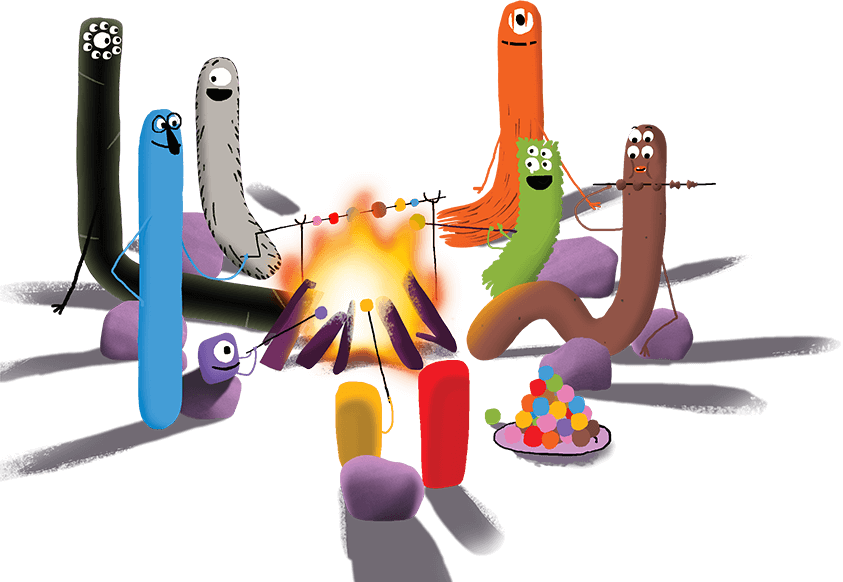The number of kids reporting positive attitudes about math drops from 71% to only 48% between 4th and 8th grade. Early math skills are the best indicator of future school success. And yet, only 5% of preschool activities involve STEM activities. So, what can we do to build a student’s foundation in mathematics, while instilling and maintaining a positive association to the subject?
Make math social.
Researchers at the University of Washington have found that making math social increases engagement and motivation when completing mathematical tasks and assignments. Stanford University has also produced studies that show the high level of motivation that correlates with group tasks.
To take it to the next level – children also perceive group work as more fun. So, in combination with the high level of motivation, and the enjoyable nature of group work, this form of work is extremely beneficial to the classroom. And yet, one study has found that American 8th graders worked individually 80% of the time in their math classes.
A key reason for this is the possibility of an unequal learning experience. The risk of an unbalanced group cannot be denied. However, using a pedagogical approach called “complex instruction” can both rectify this unequal experience, and ensure your classroom receives the rewards of group work.
Before diving into the details of complex instruction, let’s begin by answering the question:
Why group work?
Group work can help children talk about math, and reason with the concepts in a way that offers a deep understanding of the subject. According to Allison Master, a research scientist from the University of Washington,
“Children feel more motivated when they are part of a group.”
In a study involving 141 four-year old children, researchers oversaw two activities: a math game and a puzzle game. One activity was to be completed by themselves, and the other activity was constructed to resemble a group activity.
Every group was assigned a unique color. All components of their group had the same color. For example, in the green group, the kids wore green shirts, and had a green box holding the activity inside. A poster on the wall depicted other children in the group, all wearing the same color t-shirts as the participants. They were made to feel like members of a group.
For children who did the activity without the group semblance, the poster on the wall of children completing the same activity did not match the color of their t-shirts. The children were made to feel individualized. The researchers even went so far as to show the children the difference in t-shirt color between them and the children in the poster.
The findings showed that even young kids are motivated by the group principle of “working towards something bigger than yourself”. Both the level of motivation and the amount of puzzles done correctly increased. Additionally, the children rated the group project as more fun.
Myth: Math is Boring
Group work may be an answer to tackling this myth. Math teachers the world over have struggled with the misconception that math is boring. Group tasks can actually help to finally debunk this detrimental problem. There are many advantages to social projects that go beyond (and contribute to) the high levels of motivation found in these tasks.
Groups have more information than an individual. Every child brings a different perspective, different background, and a unique skill set to the group. Whether these groups are composed of 4 year olds or university level students, the information level is heightened with each individual who enters the group.
Collective tasks inspire thought and creativity, as well as bring more memorable exchanges of information. Studies have shown that students retain more information when working on group projects.
This social method of learning has many advantages – but it’s not without its disadvantages. As previously stated, the main problem lies in its potential inequality. One student may be shy, another may be dominant in social interactions. While shyer students may be able to contribute valuable information, they may feel unable to do so. Socially dominant students may be inclined to shaping “group think”. Additionally, some students may rely too heavily on others to complete the task. In short, the disadvantages lie predominantly in the inequality that arise out of social interactions.
So, what can be done?
Complex Instruction
Elizabeth Cohen and Rachel Lotan, along with their colleagues at the Stanford School of Education created the pedagogical approach to group tasks called complex instruction. This method derived from over twenty years of extensive research.
The goal is to provide an equal learning experience for all students. Complex instruction includes three major components. The first is:
1. Create curricula that support a multitude of abilities.
This will “foster the development of higher-order thinking skills through group work activities organized around a central concept or big idea.” The tasks should be open-ended, which require students to work together to come to a solution.
The key component of this “multiple ability curriculum” is the wide range of intellectual abilities needed to complete each task. Students from different backgrounds and academic advancement can contribute in unique ways, bringing a sense of purpose to their role in the group task. This in turn leads to a higher contribution level from each member of the group, as the task should be designed to be inclusive to a variety of skill sets.
Through the open-ended nature of the task, “discovery learning” is enabled through collective exploration of the problem. Furthermore, equal contribution from each student ensures both a high level of engagement and enjoyment when completing the group work.
2. Train your students to manage their own groups.
With special instructions, students will assume specific roles within their group. The Facilitator asks if everyone understands the discussion within the group, or if anyone has a question about the task at hand. The Team Captain serves to keep the group on task, and proceeding in an efficient and positive way; he or she also makes sure that everyone’s ideas are acknowledged. The Resource Manager gathers and oversees the required materials from the teacher, and calls the teacher over when the entire group has a question about the task. The teacher can then help the group with their question. Lastly, the Recorder notes down the questions, ideas, and conjectures of the group. Furthermore, the Recorder also prepares the presentation paper and also makes certain that all the students involved can explain the group’s solution.
3. Tend to status problems.
The teacher should observe the groups, and make sure to tend to any status problems that may arise. When students talk and work together, students learn more. Some students, such as shy students or those who are perceived (or perceive themselves) as lacking in academic skills, may not contribute as much to the group discussion. In turn, they do not learn as much.
To try to make these students more active in the group discussion, teachers should use the status treatments to widen what it means to be “smart”. This could mean surveying groups to identify these individuals. When a shyer student makes a contribution, make sure to encourage the point made. As Jo Boaler explains,
“Assigning competence is a positive evaluation. It relies on the teacher’s power as a legitimate source of evaluation as students are likely to believe the teacher’s opinion. To change not only the student’s expectations for competence, but also to raise the group’s expectations for that student, competence must be assigned publicly, so that both the student and the classmates hear it.”
Through having a multiple-ability task and specific roles, teachers can show students that each individual can have vital intellectual contributions. This method of teacher guidance serves to tend to the status problems.
4. Students learn to be responsible for their group.
Lastly, students will learn to be responsible for others in their group – they will learn how to teach and help others. This is an essential skill socially and professionally – blending essential mathematics skills with essential social skills ensures a bright future for students. Teachers can call on one member of the group to present the solution, or grade a single group member’s paper from random selection. These methods motivate students to help every member of their group understand and explain the solution.
We hope we have provided some insight into how complex instruction can work in your classroom. For more information about complex instruction, click here. At DragonBox, we believe in bringing fun and engagement to the classroom. For tips and tools on how to improve your classroom’s engagement, click here to visit our Educator’s Page.
Happy Learning!
To know more!
See the latest news from the blog.
Get the Latest Apps & News!





